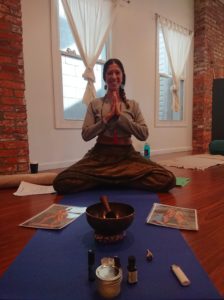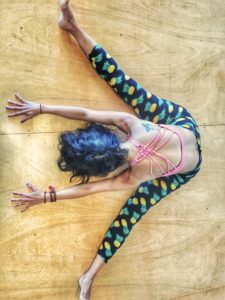 Most yoga that you practice is likely yang in nature like a Vinyasa Flow. A dynamic class that is active to a certain degree working your muscles, building strength, stamina, and flexibility. In contrast Yin Yoga (1) is a stable and passive practice where grounded poses are held for about 3 to 5 minutes with gravity deepening the pose. When holding a yin pose it tends to feel almost meditative to me and pushes me to a new edge. I usually leave class feeling rejuvenated and a bit taller like my body has been stretched straight.
Most yoga that you practice is likely yang in nature like a Vinyasa Flow. A dynamic class that is active to a certain degree working your muscles, building strength, stamina, and flexibility. In contrast Yin Yoga (1) is a stable and passive practice where grounded poses are held for about 3 to 5 minutes with gravity deepening the pose. When holding a yin pose it tends to feel almost meditative to me and pushes me to a new edge. I usually leave class feeling rejuvenated and a bit taller like my body has been stretched straight.
Michelle, a Yoga District teacher, talks about her experience with Yin Yoga. Learn about this incredibly rewarding practice and maybe try a Yin class or workshop for yourself.
Yin Yoga’s Power
 As I sat back in child pose, I felt a sudden urge to cry. It was as though my 5 year old self was holding me in present form, caressing my back while telling me I’m doing great and will be okay. I didn’t understand what was happening. All I knew was that I couldn’t hold back the tears. I began sobbing like a child in the middle of the class. Concerned by how I would be perceived by everyone around me, I tried to talk myself out of crying. “Stop! You’re being too emotional! What’s wrong with you? Everyone is watching!”
As I sat back in child pose, I felt a sudden urge to cry. It was as though my 5 year old self was holding me in present form, caressing my back while telling me I’m doing great and will be okay. I didn’t understand what was happening. All I knew was that I couldn’t hold back the tears. I began sobbing like a child in the middle of the class. Concerned by how I would be perceived by everyone around me, I tried to talk myself out of crying. “Stop! You’re being too emotional! What’s wrong with you? Everyone is watching!”
Of course, judging never works and I broke down in an even louder sob. I didn’t know why I was crying but I knew I needed a release. I left class feeling light and revived – like I had untapped a new source of energy. I wasn’t quite sure what had transcended but I knew that Yin Yoga was powerful stuff.
Unlike restorative which is more soothing and prop heavy, Yin is a healing modality by which stillness in certain asanas (poses) stimulates our fascia (2). – the stuff that literally binds us together (i.e. the connective tissue.)
Meridian Lines & Yin Yoga
 According to Dr. Motoyama (3), fascia runs along the same pathways as the energy lines/meridian lines of Ancient Chinese Medicine. So by stressing the fascia, we stimulate the energy lines inducing certain physical and emotional responses. Responses can vary according to the organ that’s stimulated – for example during the last YinDulge Yourself Workshop in June some participants shared they felt “so open” and “light” in their upper body. They felt a sensation of their “hearts overflowing” and some went on to describe a “euphoric state”. These are all effects associated with stressing and releasing the pericardium fascia which run along the heart and lung meridians (shoulders, rib cage, belly).
According to Dr. Motoyama (3), fascia runs along the same pathways as the energy lines/meridian lines of Ancient Chinese Medicine. So by stressing the fascia, we stimulate the energy lines inducing certain physical and emotional responses. Responses can vary according to the organ that’s stimulated – for example during the last YinDulge Yourself Workshop in June some participants shared they felt “so open” and “light” in their upper body. They felt a sensation of their “hearts overflowing” and some went on to describe a “euphoric state”. These are all effects associated with stressing and releasing the pericardium fascia which run along the heart and lung meridians (shoulders, rib cage, belly).
If we give ourselves permission to slow down, sense ourselves, take up space, and observe our thought patterns then we are able to access our deeply written programming. With enough practice and skill Yin Yoga gives us the opportunity to rewrite our own stories.
 What you can Expect in a Yin Class:
What you can Expect in a Yin Class:
- Longer held meditative poses (usually on the ground)
- Non active stretching (ie folding forward vs. pulling forward)
- An opportunity to tune in to the patterns of tension in our body and mind, followed by a release or sense of spaciousness in both the mind and body
- A sense of rejuvenation and increased mobility of the joints
For a taste of Yin Yoga’s power, try one of Yoga District’s Yin Yoga Yoga classes!
Sources:
- Yin Yoga https://www.yogapedia.com/definition/5216/yin-yoga
- Fascia https://www.ncbi.nlm.nih.gov/pmc/articles/PMC4173815/
- Theories of the Chakras https://www.goodreads.com/book/show/1924113.Theories_of_the_Chakras#

